Traditionally, cuisine is considered one of the most cozy places in the apartment, this is where the whole family gathers around a large table, intimate conversations are held and discussed pressing problems. Therefore, the design of this room should be taken seriously. However, many people have a question: how to decorate the walls in the kitchen? Indeed, when choosing materials, it is necessary to take into account a number of important factors, namely: their resistance to temperature changes, moisture resistance and the degree of ease of maintenance.
Modern technology involves the use of a wide range various materials. However, the most common one is paint. Firstly, due to its low cost, this material is available to absolutely everyone. Secondly, it looks beautiful on the walls, is easy to apply, has a varied palette of colors and is very durable. Therefore, if you are deciding how to decorate cheaply and quickly, in this case paint is best choice. Experts recommend using waterproof materials. They are the most resistant to abrasion.
Alkyd and acrylic paints. They are easy to apply using a roller or brush, and if desired, you can create any decorative effect using special devices. Has also worked well water-based paint. It does not contain solvents, which means it is completely safe for health. In addition, this material dries quickly, has no foreign odors, and is vapor and air tight.
How to decorate the walls in the kitchen besides paint? Another traditional choice is wallpaper. However, it should be noted that ordinary paper material should not be used when decorating this room. It is better to choose vinyl or duplex wallpaper with a washable surface. They often imitate other finishing materials: stone, brick. Such wallpapers have good moisture and wear resistance. However, it is worth considering that the duplex coating, which has a latex surface, is not recommended to be washed frequently, and it must be glued at some distance from the gas stove.

They look great in the kitchen and can be made from glass wallpaper, linkcrust or non-woven covering. Non-woven fabric has a textured surface and sufficient thickness, which allows you to reliably hide uneven walls. Fiberglass wallpapers are durable and strong. If necessary, they can even be cleaned with a brush. Also, when thinking about how to decorate the walls in the kitchen, many people choose linkrust - a universal building material. It is considered the most environmentally friendly of all the above. In its production, exclusively natural ingredients are used: wax, chalk, linseed oil and wood chips.
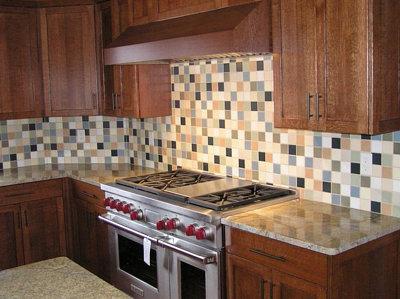
The classic way to decorate a kitchen space is with ceramic tiles. It is not surprising that many people choose it when renovating. This material is strong, wear-resistant, durable and easy to care for. As a rule, the working area of the room is decorated with tiles, and the rest is covered with wallpaper.
Also, when deciding what most people willingly use wooden or The main disadvantage of this type of finishing is a significant reduction in the free space of the room.
Very popular combined option registration kitchen walls. If desired, you can make very interesting combinations using decorative or textured plaster. It all depends on your imagination and capabilities.
How to decorate the walls in the kitchen? - this question interests many people who decide to do repairs on their own.
The kitchen is somewhat different from other rooms in the apartment, because there is high humidity, heat, fire, soot, and splashes of fat.
This means that all finishing materials for the walls and floors of the room must adequately withstand these difficult conditions. But at the same time, both aesthetic and decorative properties must be preserved.
So how can you decorate a kitchen as efficiently as possible from a technical and aesthetic point of view?
The best finishing materials to cope with this task are ceramic tiles, paint, and wallpaper.
Sometimes they use decorative plaster, and lining, and special wall panels, And OSB boards. Also recently, decorative stone, either natural or artificial, has begun to be used for finishing kitchens.

Ceramic tiles

Ceramic tiles can be different sizes, smooth, glossy or textured, matte. The choice of colors is fantastic.
Previously, when the question arose about how best to decorate it, the answer was clear: cover it all with tiles.
However, now this standard repair is not relevant and more and more people prefer to use ceramic tiles only in the area of the so-called kitchen apron, in combination with plastered, painted or wallpapered walls.
In fact, it is in the area of cooking and washing dishes that tiles are so necessary: they protect against grease, soot, and withstand temperature and humidity. And very easy to clean.
Painting the walls
Paint is another design method when the question arises of how to decorate the walls in the kitchen.
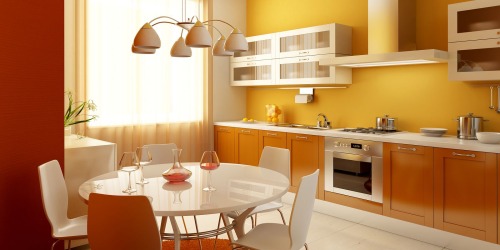
This is the most affordable material, and, in addition, it is possible to mix colors, inventing the most unpredictable shades. However, you should pay attention to some nuances.
So, in particular, the surface to be painted must be perfectly flat, without cracks. The paint must be moisture resistant, breathable and washable. Glossy paint is easy to clean, but unfavorably highlights all the imperfections of the walls. So, semi-gloss or matte paint is ideal for the kitchen.
Wallpaper
As for wall decoration, for many years our fellow citizens have become accustomed to the very simple way: wallpapering. Of course, the usual paper wallpaper They are completely unsuitable for the kitchen, especially if it has high dampness. Ideal option for kitchens - vinyl wallpaper.
Due to their coating, they are easy to wash even with a sponge and detergent; they do not peel off due to excess moisture. The fact is that they are covered with a special PVC film, which protects them from dust, dirt, soot, grease, sun rays and moisture.
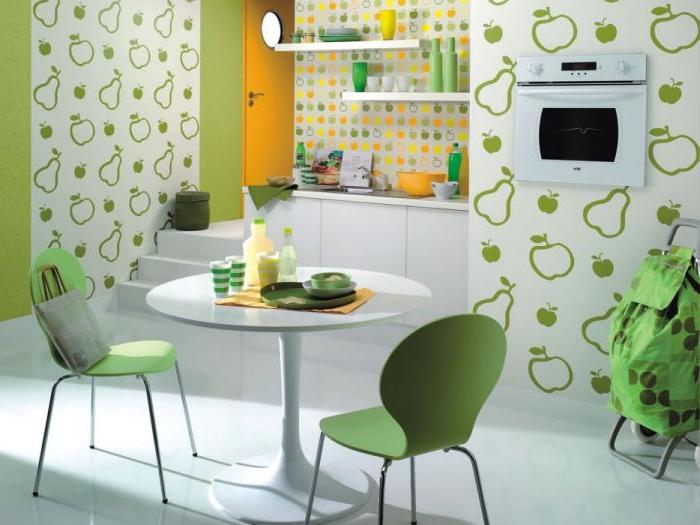
Non-woven wallpaper appeared on the market relatively recently, but has already gained popularity. They are not only durable and lightweight, but also able to hide the imperfections of the walls. Non-woven fabric allows air to pass through, which means the walls “breathe”.
They do not swell or peel off, and besides, they do not “shrink” after painting. Modern models are not afraid of even a washing brush. Another type of wallpaper is glass wallpaper. Their properties are colossal.
Not only are they easy to clean, they can withstand multiple repaints, provide water resistance and do not tear. In addition, they are absolutely fire-resistant, unlike other wallpapers, and are also capable of reinforcing walls.
Decorative plaster
Another popular, although more expensive, way to decorate walls in the kitchen is decorative plaster.. This material looks quite impressive. Can be both on water and without water based. Plasters are also divided into two types: structural and textured.

Before applying plaster, walls require pre-treatment: strength, evenness, cleanliness. Before you begin finishing, you should apply a layer of special primer under the decorative plaster.
Other types of finishing
As for the lining, this option is more suitable for those who are interested in finishing the walls at the dacha.
The lining can be either plastic or wood. Last option ideal for a country house country house, because In an apartment, such a kitchen will look somewhat out of place.
Wall panels can also be different types. Both plastic and wooden, MDF and even glass. Regardless of the material from which the wall panels are made, they require certain interior solutions to make the kitchen look organic.
OSB boards as a material appeared quite a long time ago, more than 50 years ago. But since then they have not lost their relevance. They are used for both internal and exterior finishing walls, floors, ceilings, etc.
Essentially, OSB, or OSB, is an oriented strand board. According to its characteristics, it is excellent for the kitchen, because... has high level moisture resistance, does not delaminate, is resistant to fungus and does not deform.
How to finish OSB?
In principle, these slabs already look good thanks to their natural, intricate pattern. It is enough to cover them with varnish. Or you can plaster and paint. If the slabs are used as flooring, then linoleum can be laid on top.
Apron
Perhaps the main focal point in the kitchen remains: the place at the stove and at the sink (no matter how sad it may be for housewives to hear).
These places are most exposed to heat, steam, grease, water and other delights associated with cooking and washing dishes.
Of course, simple paper wallpaper has no place in this area.
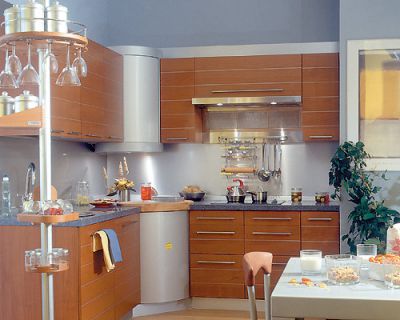
Thus, widespread received so-called kitchen aprons, or work area.
But, although the name of this piece of kitchen space is so prosaic, the work area, i.e. kitchen apron can be finished so beautifully that it will become the dominant interior detail in the kitchen.
The apron can be trimmed with wood. Look especially effective noble trees with a pronounced texture: linden, maple, ash. However, wood is very susceptible to moisture.
They come to the rescue modern technologies, which process wood in such a way that it acquires both strength and moisture resistance. You can later coat the surface with a clear varnish to preserve the texture and provide additional protection to the surface.
Glass aprons look especially impressive. This material is known for its unsurpassed qualities: it is easy to clean, comfortable, and most importantly, durable.
Modern glass processing technologies have made it possible to make this material also impact-resistant and heat-resistant. This means it will take its rightful place on the kitchen wall. There are many types of glass processing.
It can be tinted, mirrored, colored, engraved, or with an optical effect. The only negative: the better the processing, the more expensive the glass.
Laminated panels- another simple solution. But at the same time it is also quite budget-friendly.
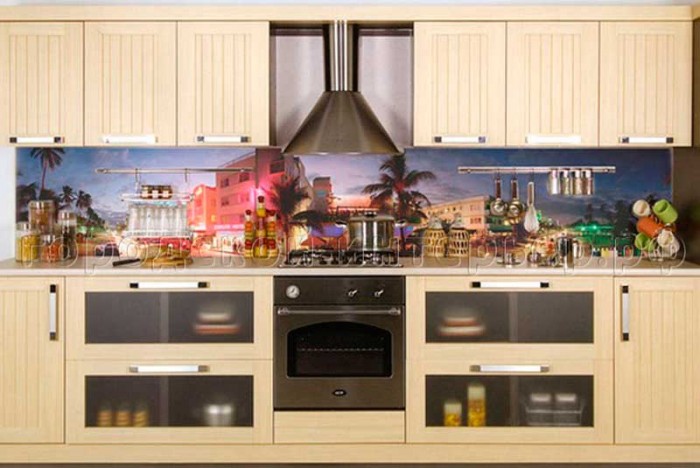
A laminate backsplash can come in a wide variety of shades and textures. It can be wood, metal, with prints, etc. Special treatment makes it impervious to dust, heat, grease stains, chemical treatments, as well as sunlight.
Those who make custom-made furniture with a tabletop will probably want the apron to look as harmonious as possible with the overall design. kitchen furniture.
This apron is made from MDF. This material has already proven itself to be moisture-resistant and impact-resistant. In fact, its characteristics are not inferior to either decorative stone or ceramic tiles.
The apron can also be made of metal. This is a very extraordinary approach to finishing. This is how, in particular, a stainless steel sheet of the required size is attached.
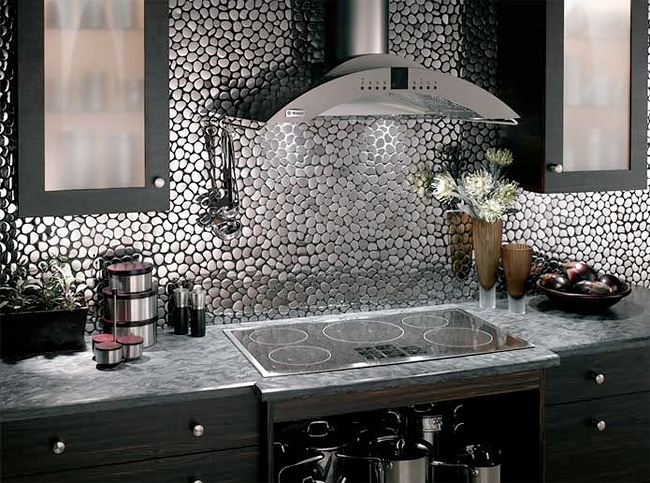
It is perfectly smooth and has a glossy shine. Just what you need for a kitchen in a modern or minimalist style.
Ceramic tiles are perhaps the most common material for finishing a backsplash. As mentioned above, ceramics has all the properties that are so necessary for decorating walls in the kitchen. Ceramic mosaics have recently gained particular popularity. Essentially, these are tiles of very small sizes (mostly 1-2 cm in width and length), from which simple or complex pattern. Even paintings and panels are created from mosaics.
How to decorate the walls in the kitchen, we share secrets
Decorating the walls in the kitchen is a delicate matter
1.
The kitchen is the place in our home where we not only prepare food. This is a place where the whole family gathers for meals, communication, and relaxation with a cup of delicious tea.
And of course, an important factor in the quality of the time we spend in the kitchen is the atmosphere that is created, first of all, by the style and interior of the kitchen.
The walls play the largest role in the interior of any room. Naturally, it is customary to approach the issue of renovation of wall decoration in the kitchen with special responsibility.
The walls in the kitchen should not only be smooth and beautiful. Taking into account the aggressive environment in the kitchen: steam, grease, dirt - the requirements for materials that
The walls in the kitchen are being repaired; they are significantly different from ordinary ones. However, if you think that decorating the walls in the kitchen will cost you a pretty penny, then this is not entirely true.

Application ceramic tiles in the kitchen
The fact is that with the variety of materials that are on the market, you can always choose high-quality ones that fully meet the necessary requirements, and,
at the same time, inexpensive materials. In addition, it is quite possible to do the renovation of the walls in the kitchen yourself.
We will tell you in this article how to select materials and decorate the walls in the kitchen yourself.
Choosing a color scheme
2.
The most important and interesting question is choosing a color scheme for the walls in the kitchen. It is on the solution of this issue that will largely depend
the effect your kitchen produces. Will it promote appetite and the spirit of communication or, on the contrary, restrain them? It is better to choose neutral tones for the kitchen,
warm: honey, peach, lemon. You definitely shouldn’t paint the kitchen in purple, blue, green, etc. colors - the effect will be the opposite.
There are several solutions from interior design specialists, let's look at them:
— Walls to match the furniture
This solution is justified for small rooms, where the main design task is to visually expand the boundaries of the room.
— Contrasting walls
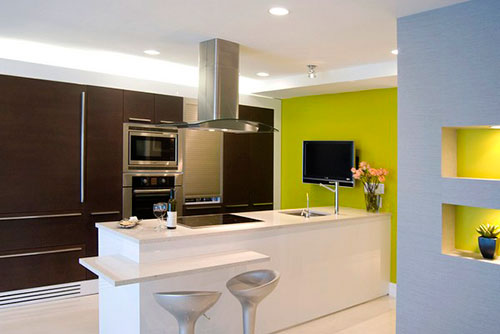
Lime color in the interior
They will allow you to create a bright, original interior in the kitchen.
— Combined interior
Interior with a zoning effect - when using color solutions the kitchen is visually zoned into a dining area, a cooking and dishwashing area, and a bar area.
We select materials
3.
So, you have decided on the color scheme of your kitchen and are ready to go to the construction supermarket for materials. Let's take a closer look at what materials
are optimally suited for this solution to this problem, and we will also get acquainted with their advantages and disadvantages.
— Wall tiling in the kitchen
Traditional (and, by the way, very ancient) material. In the article about ceramic tiles (insert link) we looked in detail at what types of tiles there are,
therefore, here we will only say that ceramic tiles are very reliable and practical material, however, if earlier, the kitchen walls were traditionally completely finished with ceramic tiles,
now they are limited to only the apron.
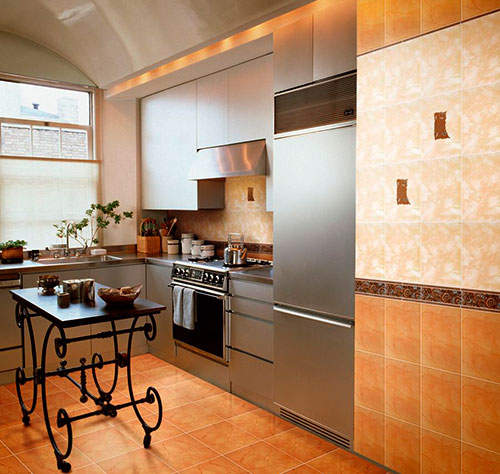
Moreover, another trend has emerged here - glass aprons or special panels are increasingly being used.
The fact is that ceramic tile mosaics have many seams, which over time become clogged with grease and dirt.
— Paint finishing
The most economical and simple option, but with the huge selection of colors that are now available, you can solve very interesting design problems.

You just need to remember that you need to choose paint for the kitchen that is moisture-resistant and resistant to high temperatures. An excellent option would be acrylic paints.
However, before painting, the walls must be prepared, since paint can emphasize the unevenness of the walls - this is its main drawback.
Enough interesting option may be painting with structural paint.
— Wallpapering kitchen walls
Also, a relatively simple option for finishing kitchen walls. Unlike painting, there are no such high requirements when using wallpaper.
to the evenness of the walls.

You can immediately say that paper wallpaper is not suitable - they absorb moisture and odors. In addition, they cannot be washed. But they will fit perfectly
vinyl, non-woven wallpaper, liquid wallpaper. Or, some kind of mixed version - paintable wallpaper - fiberglass wallpaper.
-Decorative plaster in the kitchen
A relatively new, but already very popular solution.
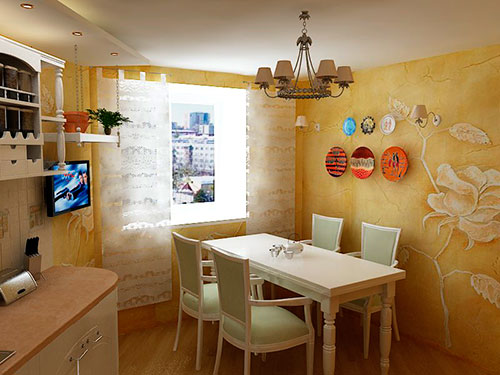
Decorative plaster looks very impressive and rich. Main types of decorative
plaster:
- Water based;
- Anhydrous;
- Structural;
- Based on marble chips;
- Venetian.
- Lime-sand;
- Polymer;
- Silicone;
- Silicate;
- Flock;
Decorative plaster is a fairly popular method of finishing walls in the kitchen; it is optimal for kitchens and hallways. can be done with my own hands from the most ordinary putty.
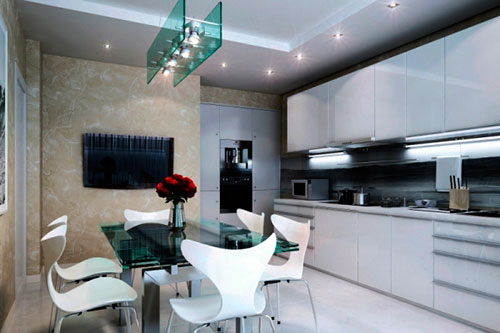
— Decorative stone
Very interesting solution, the use of which can greatly transform your kitchen. You can get off decorative stone all the walls of the kitchen,
in this case, you will get the stylization of a medieval castle.

In such an interior decorative solutions will look very harmonious, with reference to
to the Middle Ages. For example, a stove stylized as a hearth, etc.
Or, you can line a certain part of the kitchen with decorative stone, for example, the dining area.
Did you like it? Subscribe to the blog and receive new articles!
Have you decided to renovate, but don’t know how best to decorate the walls in the kitchen? To begin with, you should remember and take into account all the features of this room: its size, lighting. It should also be taken into account that the kitchen usually has high humidity, soot and splashes of oil and grease. Therefore, at a minimum, the kitchen coating should be washable, resistant to friction and moisture. The following wall finishing options in the kitchen satisfy these requirements:
- washable wallpaper;
- painting;
- ceramic tiles;
- decorative plaster;
- wood-look panels.
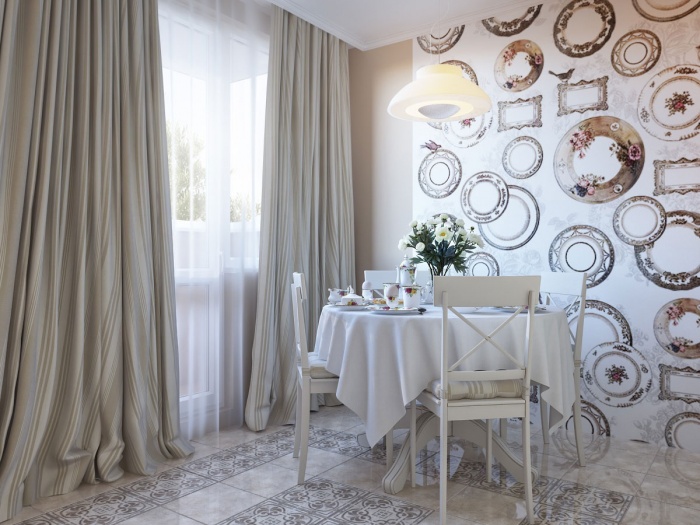
Artificial and artificial wall decoration has also recently gained popularity. natural stone to highlight zones. Let's take a closer look at the use of each kitchen design option.
Wallpaper
Decorating walls in the kitchen with wallpaper is the most common way to decorate walls. Typically, vinyl or non-woven coverings are used for this. Under no circumstances buy paper wallpaper for the kitchen; it will simply get wet and begin to peel off from the wall. Vinyl and non-woven materials tolerate moisture well and are easy to clean. Vinyl wallpaper covered with a special film that protects them from fading, moisture and dirt.

Non-woven coverings are highly durable and easily hide many wall irregularities; they do not peel off from moisture and provide sufficient air exchange with the wall, which is essential for the kitchen. Another advantage is that they are fire-resistant and can temporarily protect walls from fire.
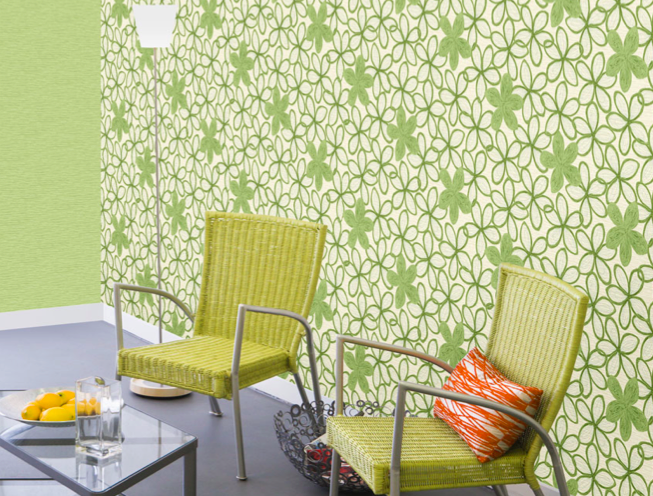
As for color schemes, it is suitable for the kitchen white, shades of gray and beige. Coverings with images of flowers, still lifes, kitchen utensils. Wallpaper in dark colors with white patterns in combination with light furniture will look good.
Painting the walls
The easiest and cheapest way to decorate the walls in the kitchen is to paint. To give the room originality, you can not just paint the walls one color, but show your imagination and make a combination of several colors. The paint should be glossy and moisture-resistant, otherwise grease will clog into the rough paint and it will be difficult to wash. This type finishing can only be used on perfectly smooth walls, since paint will not be able to hide their unevenness.

Advice! A fashionable solution it will be if you paint the eating area with a bright color, and the cooking area with a calm pastel tone.
When choosing a paint color or other kitchen finishing coating, remember that cool shades: blue, green contribute to a decrease in appetite, and warm colors: red, yellow will cause increased appetite. Of course, the choice of colors should be based on the tones of the kitchen furniture (see photo). If the set has a bright color, then it is better to paint the walls with light, calm shades. And if the furniture ensemble is made in a discreet color scheme, then the walls can be painted in brighter colors.

A new modern trend in kitchen decoration was the design of one of the walls with black paint. This surface is used to leave messages to each other, write down recipes, place children's drawings or make notes (see photo).

Ceramic tiles
IN modern interiors decorating a kitchen with tiles is becoming less and less common, since this option has already gone out of fashion. It is mainly used for finishing a work apron or some work areas. The types of ceramic tiles are very diverse, everyone can choose an option to suit their taste: glossy, textured, smooth, matte. However, using tiles in the kitchen is not without its drawbacks: dirt gets clogged into the joint between the tiles, which is difficult to clean out from such hard to reach place. Therefore, special panels or glass are increasingly used as a work apron (see photo).

Finishing is considered a modern and newfangled solution working area in the kitchen with special photo tiles. A wide-format image of some beautiful landscape, still life or family photography will give individuality. Latest technologies Applying a picture to the tile avoids the possibility of damage or fading.
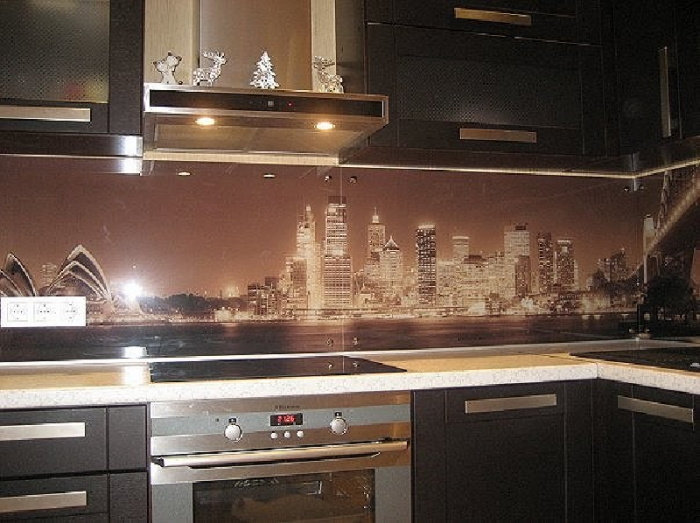
Decorative plaster
Fashionable and original solution is a kitchen finished with decorative plaster, it has many varieties:
- water based;
- anhydrous;
- based on marble chips;
- structural;
- Venetian;
- polymer;
- limestone-sand;
- polymer;
- silicone;
- flock;
- silicate.
This material will allow you to reproduce a marble surface or the look of many others on your kitchen walls. natural materials, and their color can be very different. For example, with the help of “Bark Beetle” plaster you can reproduce a cut of a tree that is riddled with passages of the bark beetle.
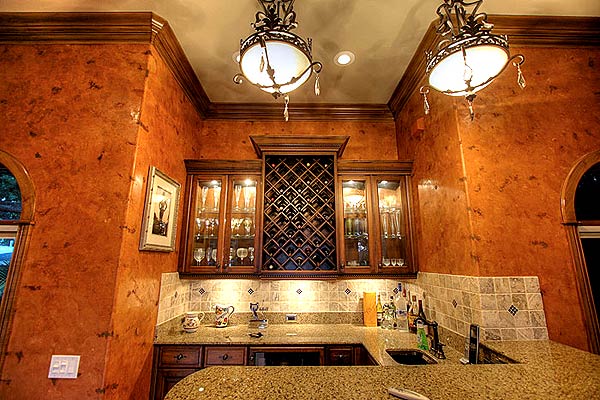
A kitchen decorated with Venetian plaster will look very impressive; it is a mixture of marble dust and polymer resin. When applying it to the surface of the walls, finish according to appearance will resemble marble. However, it should be remembered that a beautiful drawing is obtained only as a result correct technique applying plaster, and in several layers. Therefore, this is a rather expensive option for finishing the kitchen. You should not take risks and try to apply decorative plaster yourself if you do not have experience in this matter.
To protect the plastered surface from the aggressive influences of the kitchen environment, you must coat it with a special varnish. This design looks very impressive and rich.
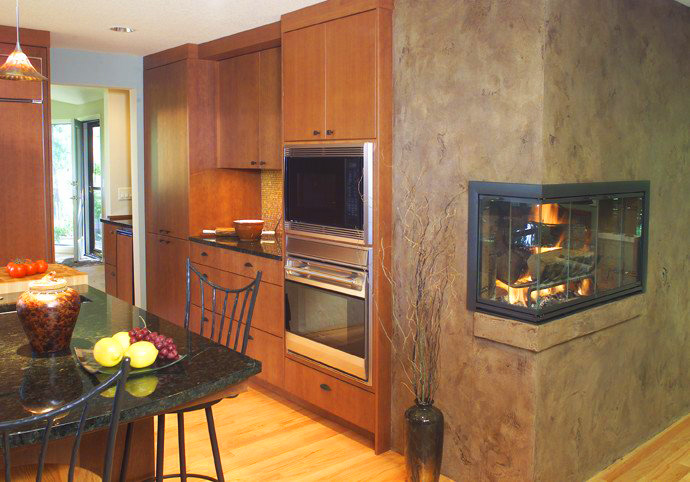
MDF panels
Also recently, finishing with medium-density fiberboards, which are briefly called MDF panels, has gained popularity. They have a lot of advantages: durable, strong, moisture-resistant, resistant to temperature changes, and the appearance of fungus or mold is excluded. These panels come in two types:
- panel painted with special high-quality bases;
- veneered, lined with veneer.
MDF is an environmentally friendly material and is quite suitable for finishing a room such as a kitchen (see photo).
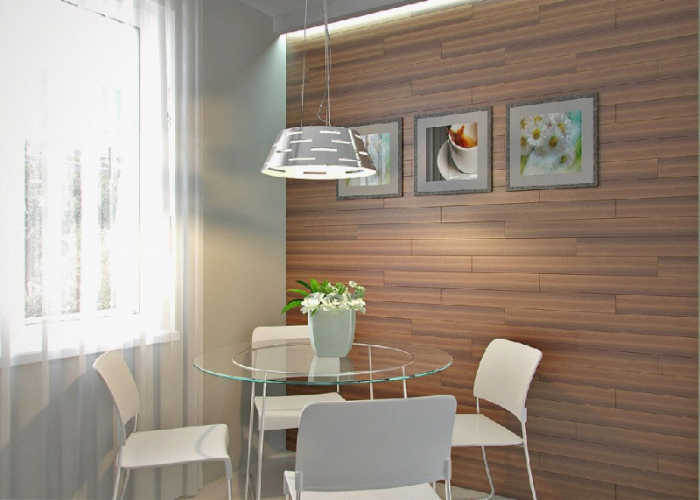
Decorative stone
The option of finishing the kitchen with decorative stone is a worthy alternative to painting, plaster and wallpaper. There are several ways to decorate a kitchen with this material:
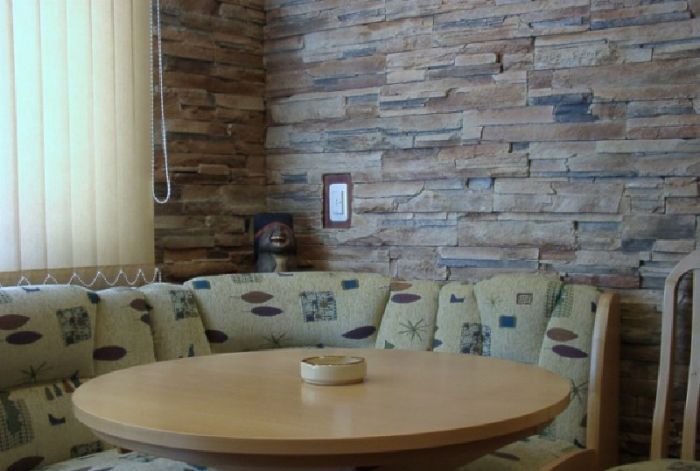
Stone coating has a low cost and can easily be combined with most modern materials, does not require maintenance - just wipe it with a damp cloth. Stone covering can be selected various forms and colors that will be in the best possible way highlight the desired design. For example, brickwork will go well with furniture that has metal parts: bar counter, table and chairs with metal legs, etc.

Kitchen design options
When decorating the walls in the kitchen, you can use the most daring solutions and combinations of various materials. Walls decorated with bright materials, combined with beautiful accessories, will add sophistication and elegance to the kitchen. You can decorate the room with a solid orange or light green color, which will give it a certain style. Accessories should be selected that would complement the chosen design and add completeness to the kitchen interior, for example, paintings, photographs, wall clock and plates, decorative elements. It is not so important which element is chosen, the main thing is that it stylistically harmonizes with the decoration of the walls.
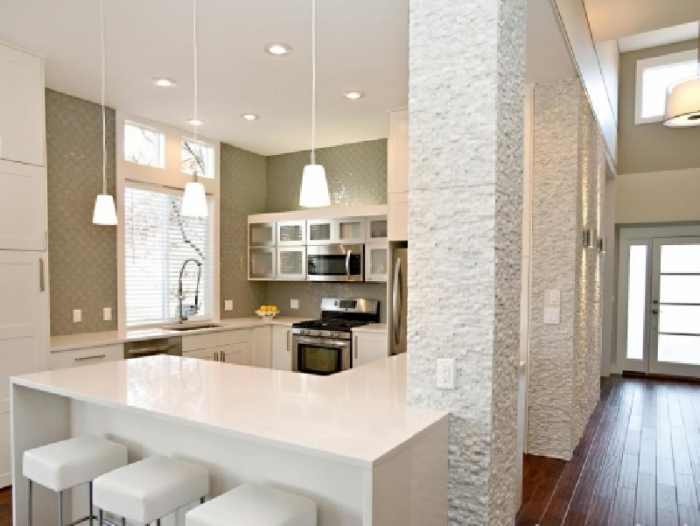
One of the classic options for decorating a kitchen is this: a picture in the middle of the wall, and on both sides of it there is a night lamp. If you turn off the main light and turn on the lamps, this will add romance and mystery to the atmosphere.
But some people are annoyed by bright colors in the kitchen; they want calm shades and a calming interior. In order for the furniture and wall covering to look like a single whole, you can choose the color of the wallpaper to match the tone of the furniture. Calm classic design does not always have to consist of only one shade. More often they use a combination of various calm tones; such a kitchen interior will look not only soft and soothing, but also fashionable (see photo). For example, against the background of white walls, you can place light furniture with a beige or gray tabletop or doors. You can do it the other way around: against a background of gray or beige wallpaper install furniture with white elements.

The kitchen can be decorated with a division of zones: the cooking area can be decorated in one color, and the eating area in another (see photo). For example, the wall for cooking can be finished in light purple, and the place where it is located dining table- light green or yellow. Also, the kitchen area can be decorated in white with gray streaks, and the remaining walls can be decorated with a bright coating.

For small kitchens, in which both zones are woven into one, there is another option for wall decoration. You should take one color as a basis, for example, white, and add splashes of bright color (blue, orange, green), which will play a secondary but important role. To use a bright color, a wall with a door or window opening can be chosen.
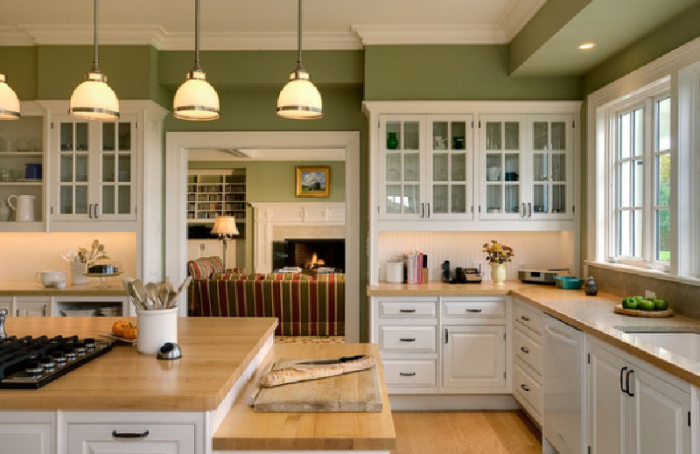
The kitchen is an important part of any home, because here the whole family gathers at a common table to not only have dinner, but also to socialize. Therefore, every self-respecting owner will make this room cozy and harmonious, so that all family members feel pleasant and comfortable staying in it.
The room in which food is prepared is a combination of cleanliness and practicality, comfort and modern decor - therefore, choosing best material for finishing the walls in the kitchen, a multifaceted assessment is carried out. The primary role is played by the ability to resist high humidity, high temperatures, grease and other contaminants.
Modern materials
The kitchen is a specific room, so the finishing material should not be afraid of:
- Moisture, steam and high temperatures.
- Use of detergents.
- Bacteria, fungi.
Different types of finishes are easy to combine with each other; this quality is used to achieve optimal ratio"exploitation-decoration".
Each material has its own pros and cons.
Tile (ceramics)
Modern tiles are varied in color, size, texture. Manufacturers decorate products with photo prints, mirror coatings, and inclusions of metal components that imitate glass. 
Advantages of ceramics:
- masking base defects - tiles hide cracks and irregularities, protect walls from destruction.
- ease of care.
- durability – after repeated treatments detergents the material does not lose color, the gloss does not wear off.
- additional decoration - methods of laying and combining tiles of unequal sizes are selected, panels are compiled.
Cons:
- complexity of installation - you will have to involve professionals or decide what to decorate the walls in the kitchen with, except for tiles.
- labor-intensive disassembly - to repair electrical wiring or change the design of the kitchen, you will need a lot of time, physical strength and a special tool.
The size of the tiles should be taken into account - large ones visually make the room smaller and vice versa.
Mosaic
And in our time (2017-2018), the material looks original on the surface and fits well into small rooms.

There are 2 types:
- Glass – increased strength, but expensive.
- Ceramic - made by analogy with tiles, a glazed coating is applied.
Pros
Decorative and performance qualities.
- Durability - used as a floor covering.
- Durability.
- Easy to care for.
Cons:
- The complexity of installation requires calling in professionals.
Painting
To decorate the walls in the kitchen without paying for professionals, it is worth remembering moisture-resistant acrylic or latex paints. There are glossy and matte varieties: the first looks great and is easy to clean, but the second hides surface imperfections better.

Advantages:
- Environmental friendliness.
- Vapor permeability - thanks to this, a normal humidity regime is created in the kitchen, the walls under the paint “breathe”, mold does not grow on them.
- Moisture resistance;
- High adhesion (adhesion) to the base.
- Relatively cheap.
Disadvantages of painting kitchen walls:
- thorough preparation of the base is mandatory - the wall is cleaned of the previous coating, removed greasy spots, wash, dry. After this, clean with sandpaper, wipe with a dry cloth and apply an antiseptic primer;
- selection of special paint - semi-gloss or semi-matte, recommended for use in the kitchen (more expensive than conventional dyes).
Wallpaper
It is distinguished by a palette of colors and a variety of patterns. The quality and durability of wallpaper in relation to kitchen conditions depends on what type it is: 
- Latex is the answer to the question of how to line the walls in the kitchen inexpensively, although the durability of the coating is measured by 20 wipes with a damp cloth.
- Vinyl is a moisture-resistant (albeit less breathable) option with a protective PVC film, allowing soft means and the use of a sponge.
- Compact vinyl - differ from the previous type in that the coating is more hygienic; they can even be washed with a brush.
- Non-woven (paintable) - lightweight, durable, vapor permeable, do not swell or shrink when wet, non-woven fabric can be repainted up to 20 times.
- Fiberglass wallpaper is a durable option that is resistant to water, acids and even fire, and can withstand repeated repainting.
The disadvantages of wallpaper are its relative fragility: they can be accidentally scratched, they deteriorate from regular washing and suffer from leaks.
Decorative plaster
This finishing coating is distinguished by a richness of textures and shades. Options with the effect of “marble chips”, “bark beetle”, Venetian plaster. They give the walls an attractive look, and tinting adds the finishing touch to kitchen interior.
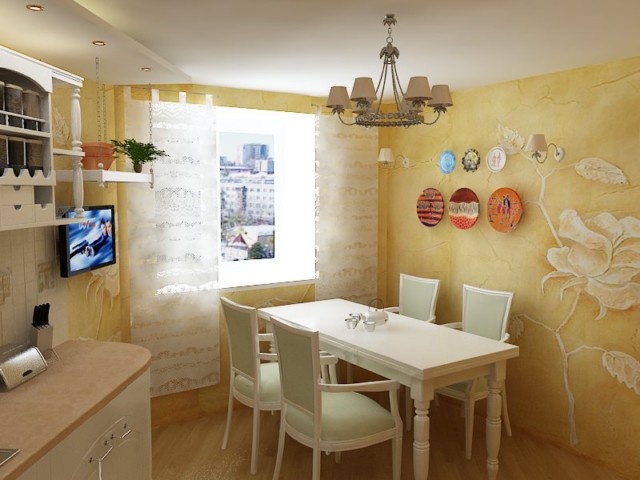
Pros:
- Applying a thin layer allows you to achieve strength while saving material.
- Resistance to heat and moisture.
- Hardness, wear resistance.
- Easy to maintain.
- Relatively cheap.
Cons:
High price, which is compensated by low mixture consumption.
Stone
The material is popular and is used in interiors to accent design elements. Easily combined with other types of cladding.

Pros:
- Light weight.
- Durability.
- Environmental friendliness.
- Easy to care for.
Brick
Often used in loft style - the use of raw materials. The contrast of the design allows you to highlight and decorate the space, for example, a working or dining area(table and chairs).
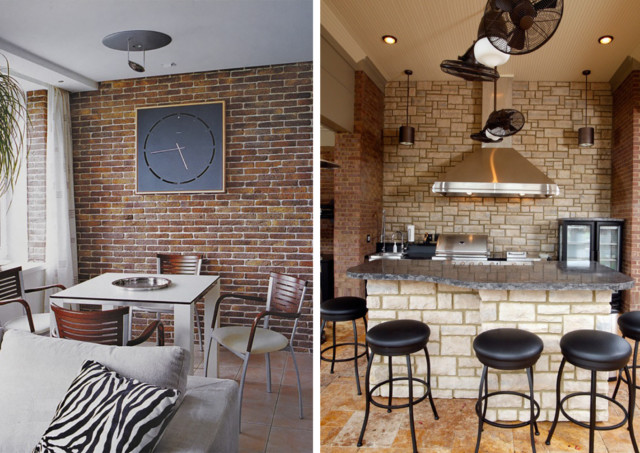
Cork
Made from tree bark. Available now in the form of tiles, rolls, wallpaper on paper based and in liquid form. The boards have two layers: 1 – backing, 2 – cork veneer.
A budget option is wallpaper, the principle of gluing is no different from regular ones. Liquid cork is applied by spray and is also used for exterior decoration due to its high protection against moisture. Has soundproofing properties. No seams.

Lining
If you need to sheathe a home (non-professional) kitchen, hallway, your living space in the country or a separate wall, use the following types:
- Double-sided seamless.
- Europrofile.
- Block house.
- Imitation of brickwork.
- Imitation of logs.
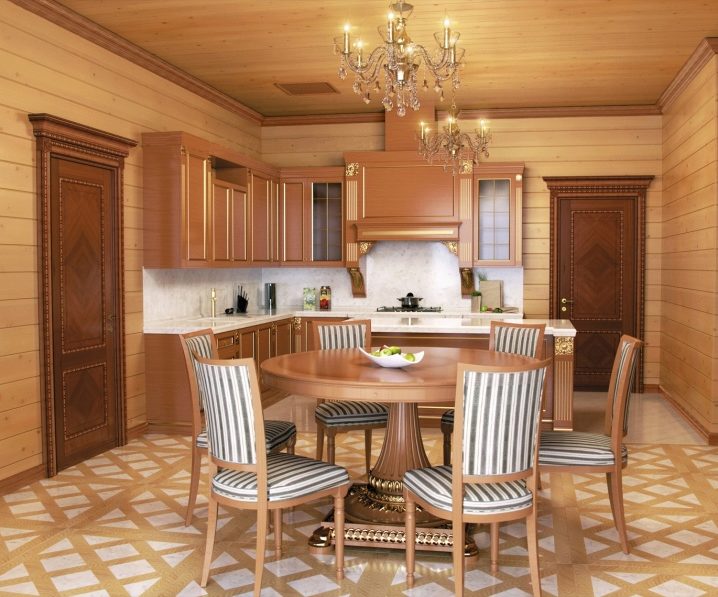
Pros:
- Environmental friendliness.
- Strength.
- Affordable price.
Pipes (gas, heating) covered with clapboard look stylish. You can use plastic to match or in contrasting colors.
Plastic
These are PVC panels. It can be installed either on the frame or glued directly to the surface.
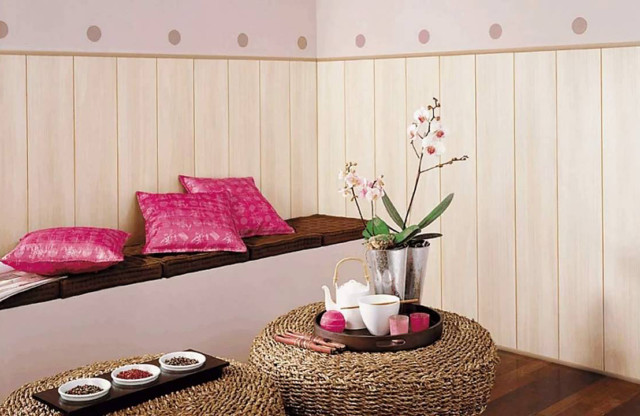
Pros:
- Electrical safety.
- Moisture resistance.
- Easy to maintain - use detergents.
- Not susceptible to bacteria and fungi.
- Variety of colors and shades.
- Budget price.
Cons:
Can't stand it high temperatures– It is prohibited to place near an open fire.
How to choose
The process of finishing premises in Khrushchev apartments or the private sector dictates its own design rules. The question inevitably arises of how and what is the best way to decorate the walls in a tiny kitchen.
Ways to visually increase kitchen space in Khrushchev are:
- Increasing doorways.
- Not continuous tiling, but only a kitchen apron.
- Gluing washable wallpaper in calm, cool tones to the walls.
You can replace wallpaper by painting the walls with light glossy paints - they also visually expand the space. At the same time, the skinali - a kitchen apron made of glass with a colored print - will become a bright spot of color.
Or they select moisture-resistant photographic wallpaper and place it in the form of inserts between plain wallpaper strips. The main thing is that the images are not too large. Photos of vegetables, fruits, and drinks would be appropriate on the walls.
Textured ones are popular for the private sector natural materials: stone, wood. In an apartment with sufficient footage it is appropriate tiles, MDF or plastic panels.
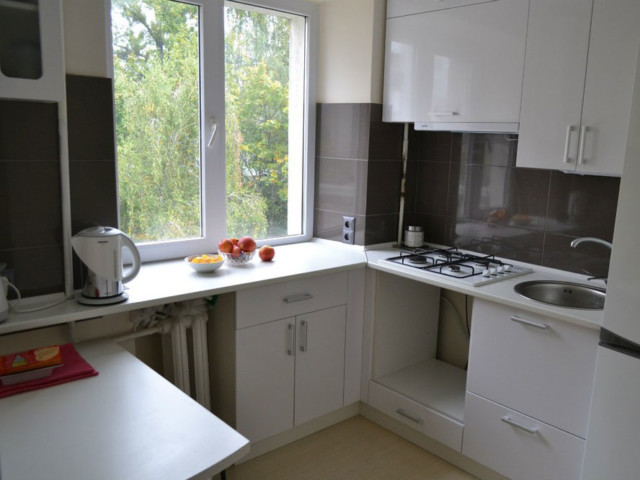
The variety of materials allows you to cover the walls in the kitchen with any accessible method, and what exactly is decided in the context of the overall design plan and taking into account hygienic requirements.
Additional wall finishing options
Apron - space between work surface And wall cabinets– requires particularly careful selection finishing material. This section of the wall is exposed to heat, grease and fumes, and requires mechanical cleaning.

The most acceptable options for finishing the apron:
- Tile or mosaic. The entire space or its local zones are laid out with tile material: above the sink and stove. At the same time, the height of the wall is covered with a margin (going under the cabinets) so that there is no gap for the accumulation of dirt. For ease of maintenance of the apron, smooth tiles are preferred. The tile seams are treated with grout or protective varnish.
- Decorative plaster. Its positive qualities are described above. The apron treated with a wear-resistant compound also becomes stylish element kitchens. Consumption – 2.5-3 kg per sq.m., it is profitable and beautiful.
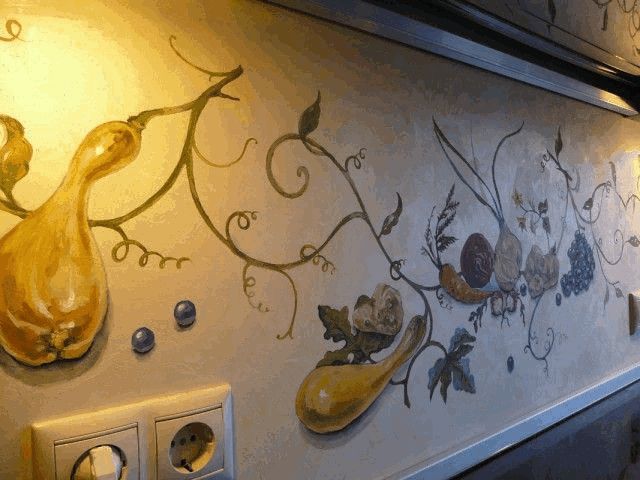
- Glass. Panels made of hardened material are made no thinner than 6 mm, which ensures shockproof strength. Aprons are painted according to special technology. The photo printing technique is also used to obtain any images. The panel is secured using canopies that are screwed to the wall - this is better than drilling mounting holes in the glass.
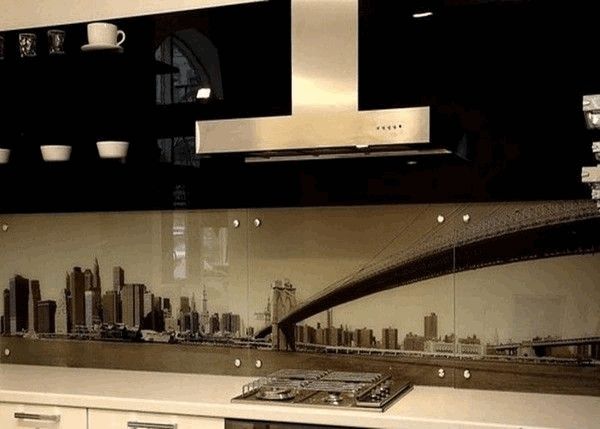
The advantages of a glass apron, in addition to strength, are thermal resistance, low abrasion, environmental friendliness - the panel does not release toxins when wiped chemicals.
- Laminated panel made of chipboard, MDF. The synthetic resin coating has good strength, low abrasion, and heat resistance. The downside is the lack of moisture resistance compared to tiles and glass, and the upside is the low cost.
After watching the video, you will learn how you can remodel your kitchen.
